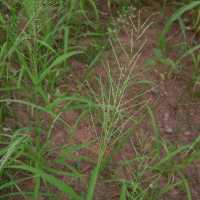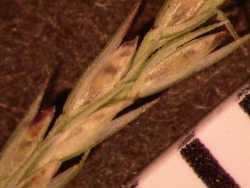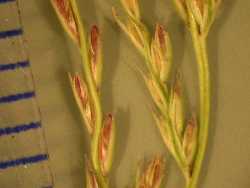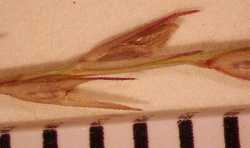Culms to 150 cm. Ligules 0.9-3.2 mm; blades 2-21 mm wide. Glumes usually not exceeding the florets, lanceolate to narrowly elliptic; lemmas 1.3-1.7 mm, shortly sericeous along the veins. Caryopses 0.9-1.2 mm, widely depressed obovate or obdeltate in cross section, usually with a narrow, shallow ventral groove, apices broadly obtuse to acute. 2n = 20.
Leptochloa panicea subsp. brachiata extends from the southern half of the United States to Argentina. It is common in disturbed and mesic agricultural sites.
Infrequent in the counties along the Ohio River. It grows in sandy soil on the slope of the bank of the Ohio River where it is washed at flood stages. Also found in sandy, alluvial fields along the Ohio River, and rarely in a similar habitat away from the river. Usually rather plentiful where it occurs.
Culms simple or branched from the base, 3-10 dm; sheaths usually overlapping, sparsely papillose-pilose; ligule 1-2 mm, fimbriate-ciliate; blades soft, flat, scabrous on the margins, the larger ones 6-10 mm wide; panicle 1-5 dm, with numerous spreading racemes 5-15 cm; spikelets 1-2.5 mm, 2-4-fld; glumes subulate or narrowly lanceolate, subequal or the second a little longer and broader, sometimes equaling or surpassing the uppermost lemma; lemmas subacute to obtuse or broadly rounded, 0.7-1.5 mm, puberulent on the veins toward the base; anthers 0.1-0.3 mm; grain 0.6-1 mm; 2n=20. A weed of gardens and fields, especially in moist soil; trop Amer., n. to Va., s. Ind., s. Ill., and S.D. (L. attenuata)
Gleason, Henry A. & Cronquist, Arthur J. 1991. Manual of vascular plants of northeastern United States and adjacent Canada. lxxv + 910 pp.
©The New York Botanical Garden. All rights reserved. Used by permission.







